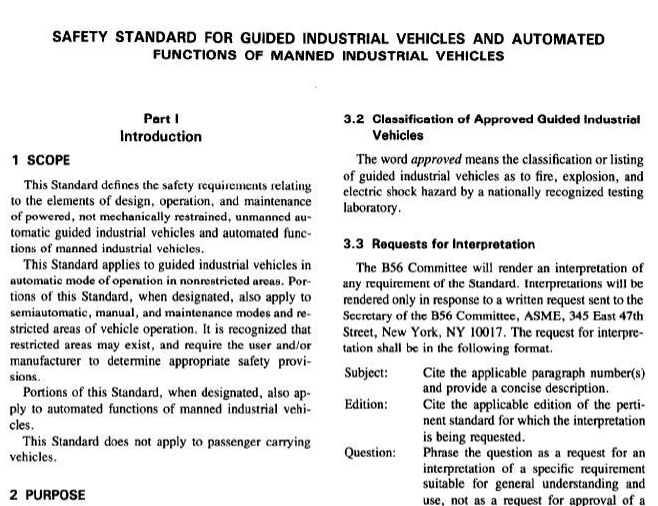ASME B56.5:1993 pdf free download SAFETY STANDARD FOR GUIDED INDUSTRIAL VEHICLES AND AUTOMATED FUNCTIONS OF MANNED INDUSTRIAL VEHICLES
1 scOPE
This Standard dcfines the safety requirements relatingto the elements of design,operation,and maintenanceof powered, not mechanically restrained, unmanncd au-tomatic guided industrial vehicles and automated func-tions of manned industrial vehicles.
This Standard applies to guided industrial vehicles inautomatic mode of oporution in nonrestricted arcas.Por-tions of this Standard, when designated,also apply tosemiautomatic, manual, and maintenance modes and re-stricted areas of vehicle operation. It is recognized thatrestricted areas may exist, and require the user and/ormanufacturer to determine appropriate safety provi-sions.
Portions of this Standard, when designated,also ap-ply to automated functions of manned industrial vehi-cles.
This Standard does not apply to passenger carryingvehicles.
2 PURPOSE
The purpose of this Standard is to promote safetythrough the design,construction,application,opera-tion,and maintenance of unmanned guided industrialvehicles and automated functions of manned industrialvehicles.
This Standard may be used as a guide by governmen-tal authorities desiring to formulate safety rules and reg-ulations.This Standard is also intended for voluntaryuse by others associated with manufacturing or use ofunmanned guided industrial vehicles and automatedfunctions of manned industrial vehicles.
3 INTERPRETATION
3.1 Mandatory and Advisory Ruloe
To carry out the provisions of this Standard, the wordshall is to be understood as mandatory and the wordshould as recommended.
3.2 Glasaificotion of Approved Guided industrial Vehicles
The word approved means the classification or listingof guided industrial vehicles as to fire. explosion,andelectric shock hazard by a nationally recognized testinglaboratory.
3.3 Requests for lnterpretation
The B56 Committee will render an interpretation ofany requirement of the Standard. Interpretations will berendered only in response to a written request sent to theSecretary of the B56 Committee,ASME,345 East 47thStreet,New York, NY 10017. The requcst for interpre-tation shall be in the following format.
Subject: Cite the applicable paragraph number(s)
and provide a concise description.
Edition: Cite the applicable edition of the pertinent standard for which the interpretationis being requested.
Question: Phrase the question as a request for an
interpretation of a specific requirementsuitable for general understanding anduse,not as a request for approval of aproprietary design or situation. The in-quirer may also include any plans ordrawings which are necessary to explainthe question;however,they should notcontain proprietary names or informa-tion.
ASME procedures provide for reconsidcration of anyinterpretation when or if additional information whichmight affect an interpretation is available. Further, per-sons aggrieved by an interpretation may appeal to thecognizant ASME Committee or Subcommittee. ASMEdoes not “approve,” “certify,””‘rate,”” or “endorse”any item,construction, proprietary device or activity.
3.4 Metric Conversions
The values stated in U.s. customary units are to beregarded as the standard.
4.1 Introduction
4.1.1 Before putting a guided industrial vehicle sys-tem into service, the user shall be responsible for allfactors affecting the operation and maintenance, as ref-erenced in Part Il of this Standard.
4.1.2 Guided industrial vehicles can cause injury ordamage if improperly used or maintained.
4.1.3 Part ll contains safety standards applicable tovehicle operations. Unusual operating conditions mayrequire additional safety precautions. Guided industrialvehicles which can be operated by manual controls mayhave restricted operational characteristics.
4.1.4 Part IV contains safety standards applicable toautomated functions of manned industrial vehicles.
4.2 Modifications. Nameplates.Markings.
Capacity, and Stability
4.2.1 Modifications and/or additions to hardware orsoftware which affect rated capacity, safe operation,orany emergency control or device shall not be performedwithout manufacturer’s verifiable approval. Where suchauthorization is granted, capacity , operation. and main-tenance instruction (plates,tags,or decals) shall bechanged accordingly.
4.2.2 The user shall see that all nameplates and cau-tion and instruction markings are in place and legible.4.2.3 When utilizing lifting equipment such as ele-vators,cranes, ship hoisting gear,elc.,to relocate aguided industrial vehicle, the user shall assure that thecapacity of the hoisting equipment being used is not ex-ceeded.
4.2.4 The user shall consider that changes in load(s).load position(s), or dimension(s),coupling type(s) orposition(s). and floor surface condition(s) or batteryweights may affect rated capacities and safe operation.Only stable or safely arranged loads shall be handled.4.2.5 The user shall be responsible for the load sta-bility and retention. When decmed necessary by theuser, verification shall be required.
4.2.6 Some users may decide to establish, for theirown use, stability requirements that will vary from thosein para.8.7.4. However, the requirements in para.8.7.4should serve as a guide for the user,working with the
ASME B56.5:1993 pdf free download
